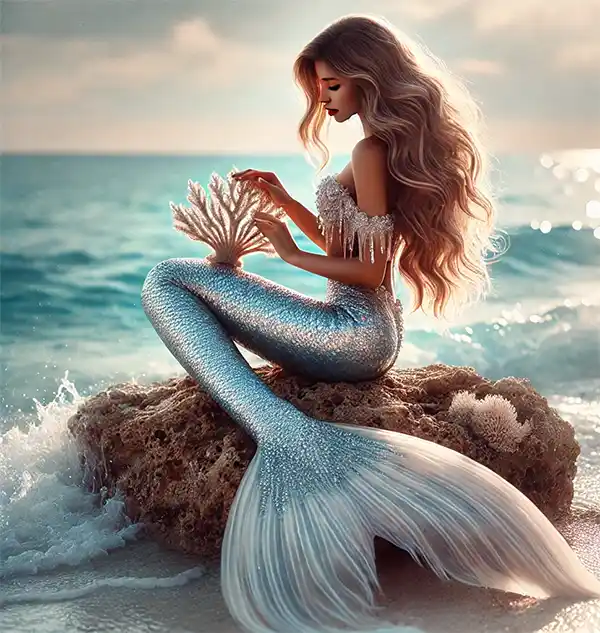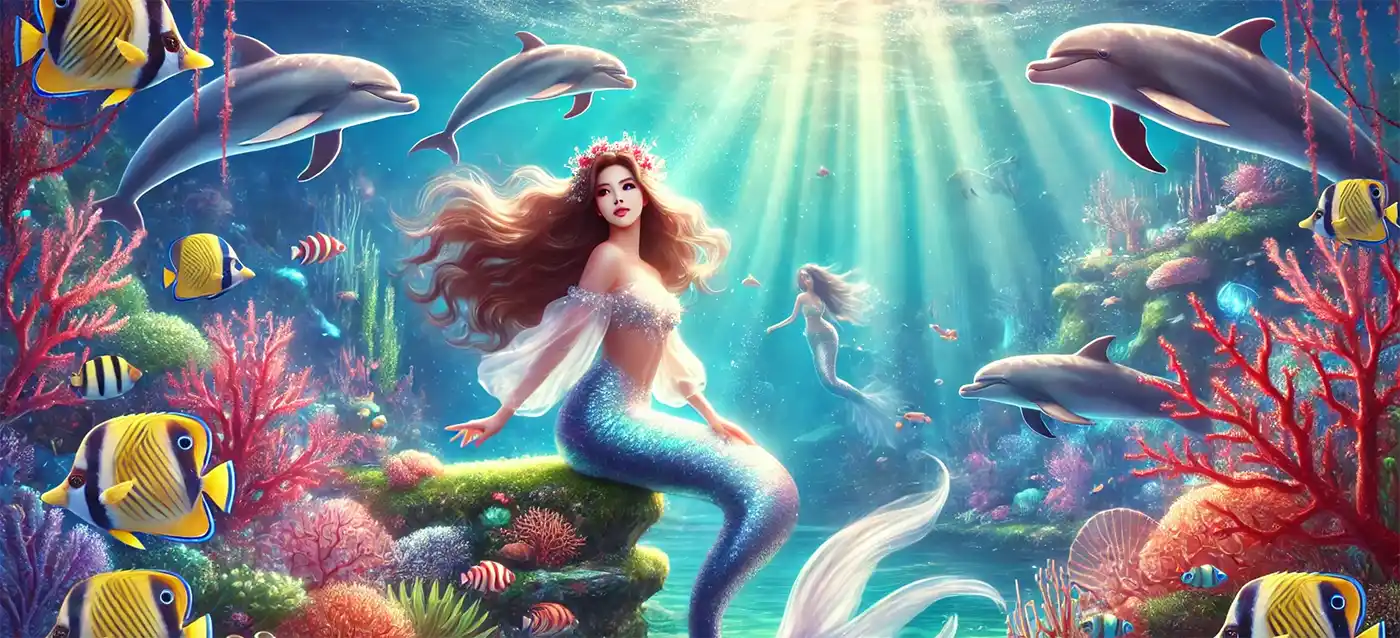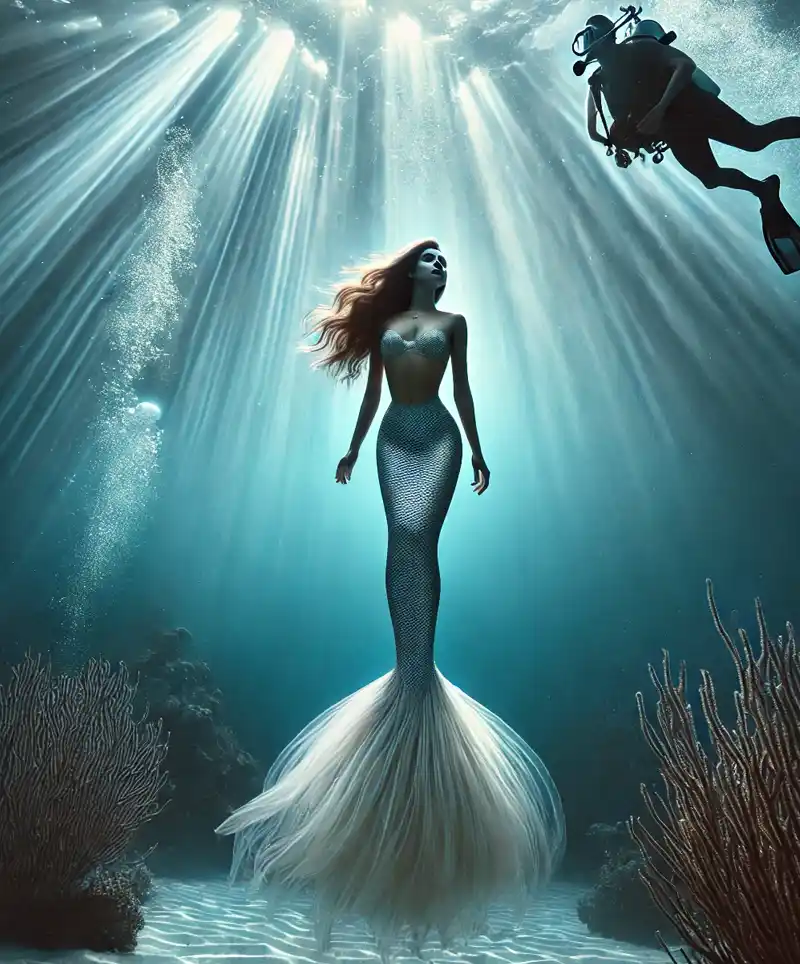Making a Splash with Sass, Scales, and Sea Shenanigans
On March 29, International Mermaid Day swims ashore with glittery tails, mysterious allure, and more sea puns than Poseidon would know what to do with. It's the perfect time to honor those mythical underwater icons who somehow manage to be majestic, mysterious, and fashionably finned—all while surviving without caffeine. Legends, we say. Literal legends.
From Folklore to Fish-Fluencers
Long before they were starring in shampoo commercials or posting underwater selfies, mermaids were making waves in myths, legends, and old sea scrolls. They've shimmered their way through nearly every corner of human storytelling, evolving from mysterious omens to oceanic influencers with sparkling tail envy.
Ancient Origins - Goddesses and Gilled Deities
Mermaids have deep roots—like “ancient-civilization deep.” One of the earliest known mermaid figures comes from Assyrian mythology around 1000 BCE. The goddess Atargatis, heartbroken over a tragic love affair (because apparently even goddesses get ghosted), dove into a lake to transform into a fish. But the waters, in a rare act of modesty, refused to cover her divine beauty completely—so she ended up half woman, half fish. And thus, the mermaid legacy began.
Other cultures weren’t far behind. Ancient Greeks gave us sirens—originally part-bird, part-woman creatures who later morphed into the more aquatic mermaids we know today. These sirens didn’t mess around; they sang sailors right into the rocks, which is kind of like being ghosted with background music. The idea was simple: beautiful and dangerous. Sort of like a jellyfish with vocal chops.
Global Mermaid Variations
Every culture seems to have its own twist on merfolk:
In Africa, Mami Wata is a powerful water spirit who’s both feared and revered. She's often depicted with long flowing hair, shimmering jewelry, and an aura of deep mystery—basically Beyoncé with a trident.
In Japan, the ningyo is a fish-like creature said to bring misfortune or storms if caught. Definitely not the type you’d want to find in your sushi roll.
In Scotland, there’s the selkie—a seal by day, human by choice if they shed their skins. They tend to fall in love with humans, which always leads to drama, identity theft, and someone running off with a coat.
In Slavic folklore, the rusalki are spirit-like water nymphs who haunt rivers and lakes, sometimes helpful, sometimes deadly. Basically, mermaids with mood swings.
So, yeah—mermaids aren’t just pretty faces with shell accessories. They're mystical, sometimes menacing, and endlessly fascinating.
From Dark Tales to Dazzling Stardom: As the centuries rolled on, mermaids went from being feared omens of storms and sea disasters to sympathetic, starry-eyed heroines. Hans Christian Andersen’s 1837 The Little Mermaid turned the tide—offering up a story where a mermaid falls in love with a human, trades her voice for legs, and suffers a tragic end. (Spoiler alert: original fairy tales were not big on happy endings or singing crabs.)
But once Hollywood got hold of the tale, the mood brightened. Disney’s version of The Little Mermaid in 1989 introduced a whole new generation to the world of undersea rebellion, catchy musical numbers, and one seriously relatable desire: to get out of the house and explore life where the people are.
Since then, mermaids have become symbols of freedom, transformation, rebellion, and sometimes just an excuse to wear glitter and avoid leg day.
The Age of the Fish-Fluencer: Fast forward to today, and mermaids have gone full influencer. They’re not just mythological anymore—they're brandable. Social media has turned mermaid fandom into a lifestyle. People wear mermaid tails to swim classes. There are mermaid fitness programs (tail included). Influencers share underwater selfies with hashtags like #MermaidVibes and #SirensOfInsta.
It’s not unusual to see folks identifying as part-time mermaids or hosting birthday parties with glitter scales and clam-shell cupcakes. Honestly, mermaids are living the dream—part fantasy, part freedom, part viral aesthetic. And the best part? No one expects them to wear pants.
 What’s So Magical About Mermaids?
What’s So Magical About Mermaids?
Let’s break it down:
- Great hair. Always beach-waved, never frizzy. We need their conditioner.
- Mystery. No one knows if they’re sweethearts, sea sorceresses, or just introverts with commitment issues.
- Singing voices that can hypnotize sailors… or possibly just win underwater karaoke contests.
- Confidence. Honestly, it takes guts to rock a seashell bra and not second-guess it.
Ways to Celebrate International Mermaid Day
Want to channel your inner sea diva? Here are a few fin-tastic ideas:
- Host a mermaid-themed tea party – Bonus points for serving snacks with ocean-themed names like “kelp chips” (spinach) or “mermosa” mocktails.
- Get crafty with mermaid art – Break out the glitter glue and shell stickers. Just accept now that your carpet may sparkle forever.
- Take a luxurious “mermaid bath” – Think sea salts, ocean-scented candles, and a waterproof speaker blaring whale songs or ‘80s power ballads.
- Do a photoshoot – Grab a shiny tail (or some flowy fabric), head to the beach or bathtub, and snap your best sultry-sea-creature look. No judgment.
- Read a mermaid book or watch a classic flick – Whether you’re into tragic romance or musical sea creatures who talk to crabs, there’s a story for everyone.
Mermaids in Pop Culture
Mermaids have been splashing their way across books, screens, and shampoo bottles for decades. Once strictly creatures of folklore, they now headline everything from animated musicals to edgy fantasy series—and don’t even get us started on how many Etsy shops are dedicated to “mermaidcore” aesthetics.
Let’s break it down by medium because these fish-tailed icons are versatile.
In Movies: The silver screen has long been obsessed with mermaids. From Disney’s The Little Mermaid, where Ariel gave up her voice for a guy (we’ve all made questionable dating decisions), to Splash (1984), where Tom Hanks falls for a mysterious woman with a secret tail and a bathtub problem, Hollywood has never shied away from diving into mermaid lore. More recent interpretations like Aquamarine and even Pirates of the Caribbean: On Stranger Tides offer everything from bubblegum pop to dark, alluring sea sirens who might kiss you or kill you—or both.
And yes, the upcoming live-action adaptations keep the wave going strong. It turns out, audiences just can't resist a character who can rock a fishtail and belt a ballad.
On TV: Mermaids have swum through countless shows, like H2O: Just Add Water, where Australian teens turn into mermaids every time they get wet—an inconvenient power when you live near a beach. There’s also Siren, a darker take on mermaid mythology, set in a coastal town where the mysterious beings are more "predator" than "princess." These portrayals show mermaids as complex, powerful, and occasionally terrifying—not just pretty faces with conch-shell phones.
In Literature: Beyond Andersen’s original heartbreaker, mermaids rule the seas of fiction. They’ve starred in everything from young adult romances to gothic horror novels where their songs lure the unsuspecting into watery doom. Mermaids in books often explore themes like freedom, identity, sacrifice, and the ultimate question: “What if I grew gills and ghosted humanity altogether?”
In Advertising & Lifestyle: From body scrubs to beach towels, the mermaid image is everywhere—glamorous, glittery, and marketable. Brands slap a shimmering tail on just about anything and boom: it’s “mermaid-approved.” Need shampoo to give you mythical volume? Done. Want a coffee mug that says “Part-Time Mermaid”? You got it. They’ve become a branding dream, appealing to anyone who’s ever wished they could ditch pants and live underwater.
On Social Media: Instagram and TikTok are flooded with “real-life mermaids” showing off their tails, practicing underwater dancing, or giving makeup tutorials for “ocean goddess vibes.” There are even professional mermaid performers who appear at events and aquariums, proving you can live the dream—though you might need breath control and a good chiropractor.
Some of these social media stars have full-blown fan bases, sponsorships, and platforms dedicated to ocean conservation. Because being a mermaid isn’t just about looking magical—it’s about protecting the magic, too.

International Mermaid Day is more than just a chance to wear glitter and sing sea shanties (although yes, please do both). It’s a celebration of fantasy, self-expression, and our enduring love of the magical and mysterious. Whether you’re a hardcore believer in oceanic enchantresses or just enjoy a good excuse to wear blue eyeshadow and hum “Part of Your World,” March 29 is your day to flip your fins and make a splash.
So go ahead—be a mermaid in a sea of ordinary.
Please Share our Content






 What’s So Magical About Mermaids?
What’s So Magical About Mermaids?









 "Sláinte!" is a traditional Irish expression used as a toast, equivalent to "Cheers!" in English.
"Sláinte!" is a traditional Irish expression used as a toast, equivalent to "Cheers!" in English.